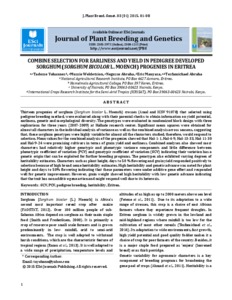Combine selection for earliness and yield in pedigree developed sorghum (sorghum bicolor l. Moench) progenies in eritrea
Abstract
Thirteen progenies of sorghum (Sorghum bicolor L. Moench) crosses (Amal and ICSV 91078) that selected using pedigree breeding method, were evaluated along with their parental checks to obtain information on yield potential, earliness, genetic and morphological diversity. The genotypes were evaluated in randomized block design with three replications for three years (2007-2009) at Halhale research center. Significant mean squares were obtained for almost all characters in the individual analysis of variance as well as the combined analysis across seasons, suggesting that, these sorghum genotypes were highly variable for almost all the characters studied, therefore, would respond to selection. Mean values for the combined analysis of the progenies showed that Hal-1-1, Hal-4-9, Hal-13-33, Hal-11-30 and Hal-9-24 were promising cultivars in terms of grain yield and earliness. Combined analyses also showed most characters had relatively higher genotypic and phenotypic variance components and little difference between phenotypic coefficient of variation (PCV) and genotypic coefficient of variation (GCV) indicating their variation has a genetic origin that can be exploited for further breeding programs. The genotypes also exhibited varying degrees of heritability estimates. Characters such as plant height, days to 50 % flowering and grain yield responded positively to selection because of high broad sense heritability estimates. High heritability and genetic advance was noted for plant height and days to 50% flowering indicating that these parameters were under additive gene effect and responded well for genetic improvement. However, grain weight showed high heritability with low genetic advance indicating that the trait has non additive gene action and might respond well due to its heterosis

